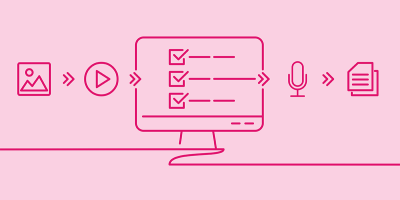
A Guide to Metadata Mapping

If you want to get somewhere in the quickest way possible, you map your course. The same is true for navigating your digital asset management (DAM) system.
Metadata powers search within a digital asset management (DAM) system. Without it, your assets become unfindable and, ultimately, unusable. But we know entering metadata can be time-consuming. So how do you ensure you’re entering metadata in the quickest way possible? Metadata mapping.
What is metadata mapping?
|
The process of metadata mapping is a way of associating equivalent metadata values or fields from one system with content in another system. |
While metadata fields may be updated individually, this process can be tedious and slow. Metadata management requires different approaches for different upload processes. Metadata mapping is one of those approaches and it allows large amounts of metadata to be simultaneously assigned from another source either automatically, continuously, or as a one-time import.
How to map metadata
To map your metadata, you first need to determine your metadata structure. (Need help? Start by understanding the metadata options within your system and work with your team to build your metadata taxonomy.) From there, start to source metadata that already exists throughout your organization and tools. Then, begin mapping your process to align it with your structure.
Let’s look at some things to consider when outlining your mapping process.
1. Understand where your information already exists
You probably have tons of metadata in existing sources and systems, but you might not be calling it "metadata" quite yet. If you’re using stock photography or shooting in-house, there’s likely already metadata attached to these assets. Pulling metadata from other tools like a product information management (PIM) system or an internal content system will align information across platforms and reduce inconsistencies. Determining where metadata already exists will cut down on duplicate efforts when tagging assets in your DAM system.
2. Determine which type(s) of mapping you’ll use
When it comes to metadata mapping, there are quite a few options to choose from. Armed with an understanding of where your data can be pulled from will help narrow down the best options for you.
One-time imports: This type of import is often used to move metadata from one DAM tool to another or to update the metadata on assets that already exist in the DAM system. A one-time import uses an XLS or CSV spreadsheet to add metadata based on a unique qualifier, most likely the file name of the asset. With this import option, the bulk of the work is done ahead of the import. But once it’s ready, the metadata fields and values are populated simultaneously making it a great option for unique metadata tagging.
Imports by file name: If you have a standard file naming convention and standard metadata values, metadata can be continuously and automatically mapped to metadata files using a script running in the background of your DAM system. Values are listed in an XLS spreadsheet and mapped to elements used in the file name. For example, if the file name is 1134_BRN_12142022_PJK, the metadata mapping could be:
Job Number: 1134
Color: Brown
Date: 12/14/2022
Photographer: Peter J. Kettle
Automatic imports: If you’re working with digital photographers who use apps like Adobe Bridge, Lightroom, or Photoshop, automatic imports can be a great time saver. XMP, IPTC, or Exif metadata that is already captured with each photograph is mapped automatically to the DAM system upon upload. Photographers can also add metadata to photo apps and these fields can be mapped directly to existing fields within the DAM system. This is particularly helpful when working with freelance photographers, as they enter all of the information into their tools during the editing process and then the metadata is transferred to the DAM system upon upload. This saves the DAM admin from spending time tracking down the specific details for each shoot.
API imports: These are the most versatile imports as they are customized based on the specific tools and needs of an organization. An API import allows teams to write their own integration to dynamically update metadata from sources like a PIM platform or content management system (CMS) into the DAM platform in real time. Teams can also choose how frequently these metadata imports are made based on their own internal workflows. This type of import works best to keep information synced across all tools used throughout an organization.
3. Work with your DAM team
Finally, you’ll need to connect with your DAM provider in order to get your mapping set up. Some tools, like one-time imports, are automatically included in your subscription, while an API integration will require help from your IT team to set up. Determine who across your organization and DAM partners needs to be involved in making your metadata mapping dreams come true.
DAM and metadata
When it comes to metadata mapping, keep your eyes open for opportunities to streamline and move quickly. Combine efforts with other tools and look for options that fit best with your current processes and workflows. Doing so will keep your metadata running smoothly and get you to your destination as quickly as possible.
Metadata truly is the lifeblood of your DAM system so it’s important to develop quality metadata that will allow your users to find what they’re looking for quickly. You’ll also want to leverage other efficiency-promoting principles like controlled vocabulary lists and image metadata best practices. Your DAM vendor might have helpful tools, too. For example, Acquia DAM (Widen) offers a metadata importer that allows you to add metadata to thousands of assets at once. Understanding your metadata options will keep your metadata streamlined and effective.
If you’re searching for a new DAM solution and want to see how we handle metadata, take a free tour or watch an on-demand demo of Acquia DAM to see it in action. Or, if you’re ready to chat with someone about your DAM needs, request a live demo and our Advisor team will be in touch.
Note: This article was originally published on Widen.com.



